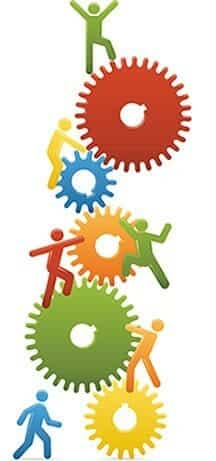Project managers need to be able to master the art of quickly making new group compositions effective. Project groups often consist of people who do not otherwise usually work together. All new groups go through a number of phases before the collaboration works and the group becomes effective. This post is about how you as a project manager can speed up this process, which can otherwise take a long time.
Most groups go through the following two phases, among others:
One empathy phase, where employees study each other to "figure out" who the others are, what you can say, joke about, etc.
One conflict phase where the group questions most things and even you as a project manager will probably be questioned. - Why did you get this role? The person may think that he / she is more suitable for the project manager role.
During these phases, the group is unproductive. In the worst case, the project team never comes out of the conflict phase, which is devastating for a tight schedule. However, there are some tips that can speed up the way to an effective project team.
Tips on how to quickly get good collaboration in your project group
Try to identify the areas in which there is a risk of conflicts arising. A basic principle is to try to meet olle in the gate, ie to clarify all conditions through proactivity and communication. If it is done before the discussions start, which can degenerate into conflicts, then often a lot of time is gained and the power can be put on the right things. Without tools to speed up the process, it can take a very long time before you have a well-functioning group.
A kick-off, preferably in combination with a team-building activity, is a very good opportunity to clarify conditions, goals, rules of the game, roles and approaches.
Here are examples of some areas where ambiguity can lead to conflict and time-consuming discussions. Exactly which areas and questions are relevant for your particular project, only you can answer. Try to familiarize yourself with each project employee's situation. What does he / she need to know in order to be able to take on his / her tasks as quickly as possible without misunderstanding.
Who - Who will do what in the project? Clear roles with well-defined responsibilities and powers. What does each person fulfill for function? Everyone can present themselves and tell them what their task is.
What - What are the goals of the project? Here, as a project manager, you also have a great opportunity to create commitment by conveying how interesting and important this particular project is and how fun it will be to work in it together.
How - How should the work be performed? Which project model should be used? Inform about meeting frequency and what you expect from your employees, eg how reporting and follow-up should go.
When - When will the project be ready? What does the schedule look like? Make sure your employees are involved in developing their individual schedules, so they feel that this is something they really stand for.
Glossary - Sometimes a lot of abbreviations are used in projects. Make a glossary of what they mean. For example, if you have consultants or project members who have worked in other organizations, the same abbreviation may mean a completely different thing to them.
Norms - A norm is a rule and can be stated or unspoken. Who, what, how and when according to the above are examples of norms. Other examples of norms are, for example, rules for leave, working hours and overtime. Make sure that the standards are clear, so that energy can be put into the project and not into discussing what applies.
Hidden norms - Hidden norms are things that we usually do not talk about, ie how the cooperation should work and how we should relate to each other.
The project manager role - Your role as a project manager can be questioned, which can make the whole project ineffective. Therefore, tell us early on what your role entails. If someone thinks he / she would be better suited than you, answer the statement that this time you have this role but that there are certainly times when the other can apply for a project manager role.
This blog post was mainly written by Elisabeth Weidel, who has extensive experience in training managers and project managers in group dynamics. An optimal project group requires a good collaborative climate. How you create this we will write about in a future blog post.
Do you have any tips that you want to share to get effective groups quickly? Comment below!
